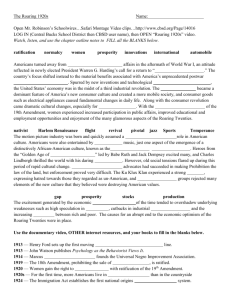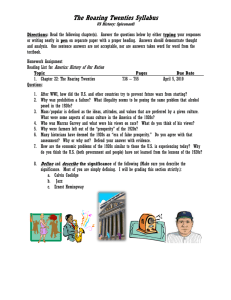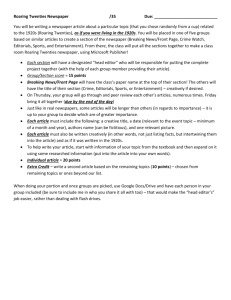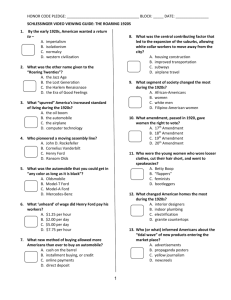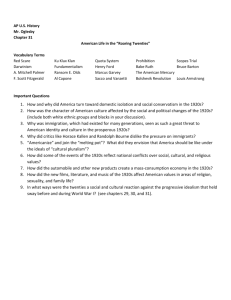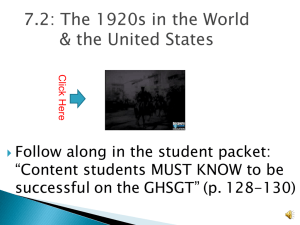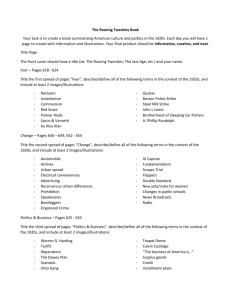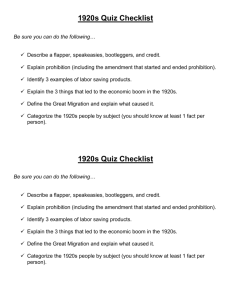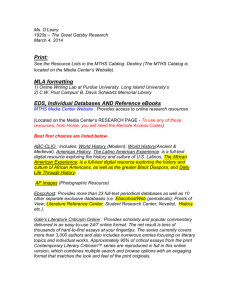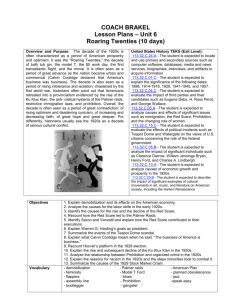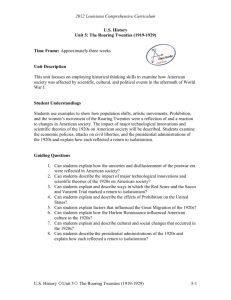The roaring Twenties - Schilessinger vhs
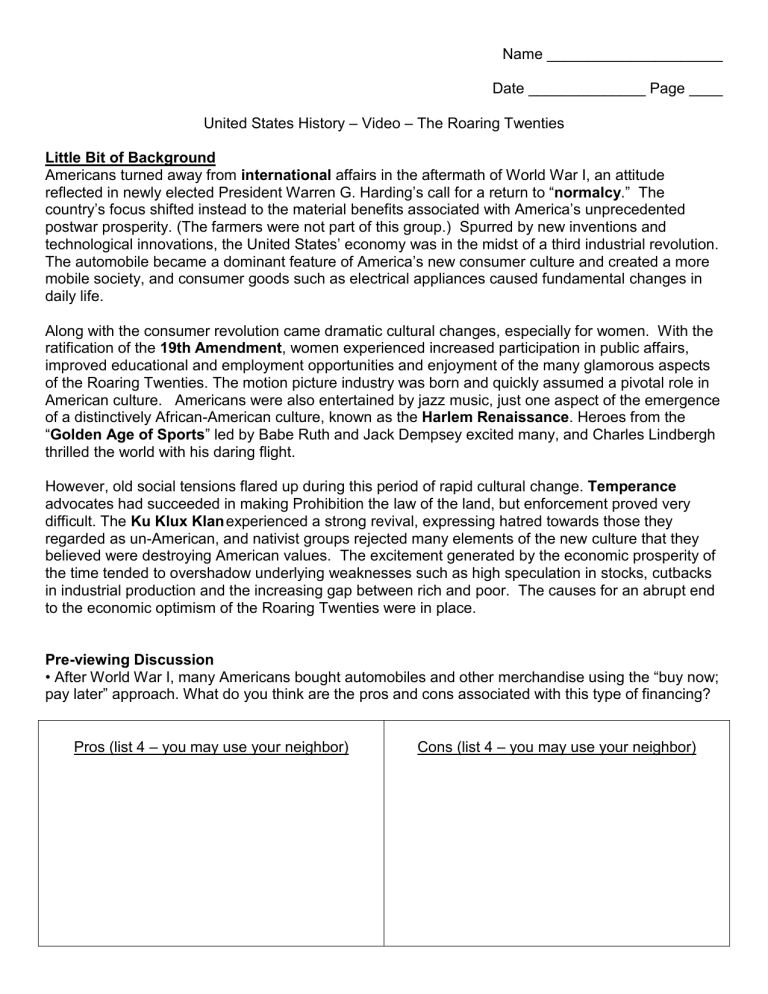
Name _____________________
Date ______________ Page ____
United States History – Video – The Roaring Twenties
Little Bit of Background
Americans turned away from international affairs in the aftermath of World War I, an attitude reflected in newly elected President Warren G. Harding’s call for a return to “ normalcy .” The country’s focus shifted instead to the material benefits associated with America’s unprecedented postwar prosperity. (The farmers were not part of this group.) Spurred by new inventions and technological innovations, the United States’ economy was in the midst of a third industrial revolution.
The automobile became a dominant feature of America’s new consumer culture and created a more mobile society, and consumer goods such as electrical appliances caused fundamental changes in daily life.
Along with the consumer revolution came dramatic cultural changes, especially for women. With the ratification of the 19th Amendment , women experienced increased participation in public affairs, improved educational and employment opportunities and enjoyment of the many glamorous aspects of the Roaring Twenties. The motion picture industry was born and quickly assumed a pivotal role in
American culture. Americans were also entertained by jazz music, just one aspect of the emergence of a distinctively African-American culture, known as the Harlem Renaissance . Heroes from the
“ Golden Age of Sports ” led by Babe Ruth and Jack Dempsey excited many, and Charles Lindbergh thrilled the world with his daring flight.
However, old social tensions flared up during this period of rapid cultural change. Temperance advocates had succeeded in making Prohibition the law of the land, but enforcement proved very difficult. The Ku Klux Klan experienced a strong revival, expressing hatred towards those they regarded as un-American, and nativist groups rejected many elements of the new culture that they believed were destroying American values. The excitement generated by the economic prosperity of the time tended to overshadow underlying weaknesses such as high speculation in stocks, cutbacks in industrial production and the increasing gap between rich and poor. The causes for an abrupt end to the economic optimism of the Roaring Twenties were in place.
Pre-viewing Discussion
• After World War I, many Americans bought automobiles and other merchandise using the “buy now; pay later” approach. What do you think are the pros and cons associated with this type of financing?
Pros (list 4
– you may use your neighbor)
Cons (list 4
– you may use your neighbor)
• By the 1920s, going to the movies became an extremely popular American pastime. What do you think was the historic and modern impact of movies and movie stars on American culture?
• Electricity and new electrical appliances were introduced in the 1920s. How would life be different without these technological advancements?
A brief Time Line – put this on a an appropriate time line of your making.
1913 — Henry Ford sets up the first moving assembly line.
1913 — John Watson publishes Psychology as the Behaviorist Views It .
1914 — Marcus Garvey founds the Universal Negro Improvement Association.
1919
— The 18th Amendment, prohibiting the sale of alcohol, is ratified.
1920
— Women gain the right to vote with ratification of the 19 th Amendment.
1920s
— For the first time, more Americans live in cities than in the countryside.
1924
— The Immigration Act establishes the first national origins quota system.
1925
— The Scopes trial is held in Tennessee.
1927
— Duke Ellington brings his band to the Cotton Club in Harlem.
1927
—
The Jazz Singer
, the first “talkie” movie, is released.
1927 — Charles Lindbergh is first to fly solo across the Atlantic Ocean.
1929 — The stock market crash signals the end of the Roaring Twenties.
Vocabulary – Using a minimum 8 vocabulary words, write a brief summary of the video we just watched. You may work with a partner ONLY if you are working with a PARTNER
Progressivism — An American reform movement within both major political parties, from about 1890 to World War I, that pressed for legislation to reform many aspects of America’s urban and industrial systems.
“The Jazz Age” and “The Roaring Twenties” — Terms used by historians to characterize the decade of the 1920s.
Third Industrial Revolution — The shift in the 1920s towards relying on electricity for power and utilizing the assembly line for the mass production of consumer goods.
Model T
— A reliable, affordable car that was designed, manufactured and sold by Henry Ford. It became one of the most popular American-made cars in history. mass consumer culture
— The desire of producers to sell, and of consumers to buy, the many new products developed in the 1920s, such as electrical appliances.
19th Amendment
— The Constitutional amendment that gave women the right to vote. speakeasies — Places where alcoholic drinks were sold illegally during the time of Prohibition. flappers
— Young women of the 1920s who sought to liberate themselves from old social rules and customs and to enjoy life fully and on a basis equal with men. snake oil salesmen
— A term used to describe dishonest salesmen in traveling medical shows or in country fairs, who sold bottles filled with worthless mixtures as medicinal cures.
Universal Negro Improvement Association — A large African-American organization founded by
Marcus Garvey to promote racial pride, economic self-sufficiency, and the formation of an independent nation in Africa.
Harlem Renaissance
— An outpouring of literary and musical creativity by African Americans in the
1920s, centered in New York City.
The Cotton Club
— A popular nightclub in Harlem where white patrons came to enjoy entertainment by African-American performers, including Duke Ellington. blues — A form of melancholy music originated by African Americans in the South.
Prohibition — A time in American history, following the passage of the 18th Amendment, when it was illegal to produce, transport or consume alcoholic beverages.
Ku Klux Klan — A secret terror organization dedicated to white supremacy, first organized in the
South after the Civil War. nativism
— A postwar phenomenon characterized by Americans’ distrust of foreigners and foreign influence.
“Golden Age of Sports” — A time in the 1920s when sports became tremendously popular and top athletes like Babe Ruth, Jack Dempsey, Bill Tilden, and Red Grange became sports heroes.
Scopes trial
— A controversial trial in which John Scopes, a high school teacher, was convicted of breaking a Tennessee law outlawing the teaching of evolution.
The Gospel of Business — During the boom of the 1920s, the strong belief in American corporations and prosperity, best expressed by President
Coolidge, that “The chief business of the
American people is business.”
Follow-up Discussion
• Prohibition was repealed on December 5, 1933.Why do you think this ban on alcohol failed?
Do you think the failure of this effort means that all laws like it would fail? Why? Why not?
• Interpret and evaluate President Coolidge’s statement, “The chief business of the American people is business.”
• Describe the underlying problems of the American economy in the 1920s. Consider the effect these weaknesses had on the future.

